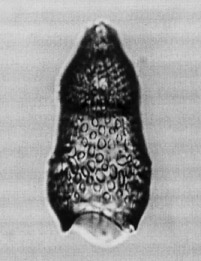 Podocyrtis
(Lampterium) helenae Nigrini
Podocyrtis
(Lampterium) helenae Nigrini Podocyrtis
(Lampterium) helenae Nigrini
Podocyrtis
(Lampterium) helenae NigriniPodocyrtis (Lampterium) helenae Nigrini, 1974, p.1070, pl.lL, figs.9-11, pl.4, figs.4-5
Shell smooth, quite thick-walled. Cephalis [three-lobed], subspherical with many subcircular pores and thorn-like 3-bladed apical horn. Thorax campanulate with subcircular pores either aligned longitudinally (5 to 7 in a row) or irregularly arranged, seven to nine on a half-equator. Lumbar stricture distinct. Abdomen elongate, expanded distally with subcircular pores sometimes aligned longitudinally (8 to 13 in a row) but often irregular, 8 to 12 on a half-equator. Ridges between the longitudinal rows may become sinuous to follow irregularities in pore arrangement. Peristome rather wide, smooth, poreless with three spathulate feet (Nigrini, 1974).
Based on 20 specimens. Length of thorax 50-65 µm; of abdomen (including peristome and feet) 133-248 µm. Breadth of thorax 83-100 µm; of abdomen 115-150 µm (Nigrini, 1974).
P. (L.) helenae is distinguished from P. (L.) sinuosa and P. (L.) mitra by the abdominal pores being smaller and less regularly arranged, and the abdominal wall being generally thinner (Sanfilippo et al., 1985).
The smooth shell resembles that of P. (L.) mitra in its general truncate-conical form, and varies from thick-walled to (more usually) quite delicate. Abdominal pores are sometimes aligned longitudinally but are more often irregularly arranged and unevenly distributed. Ridges between the longitudinal rows in some specimens become sinuous because of the irregularities in pore arrangement (Sanfilippo et al., 1985).
This middle middle Eocene species is found in low latitudes in the Atlantic and Indian Oceans. No samples of this age are available from higher latitudes. Its morphotypic first appearance lies within the Podocyrtis ampla Zone. Its morphotypic last appearance lies within the Podocyrtis mitra Zone.
This species is apparently an evolutionary offshoot from P. (L.) sinuosa, and left no descendants.
Additional illustrations can be found in Riedel and Sanfilippo, 1973, pl.4, figs.4-6.